
- Home
- NG Hindi
- India
- World
- Politics
- Sex & Relationships
- Entertainment
- Culture
- Lifestyle
- Economy
- Sports
- Sp. Coverage
- Misc.
- NewsGram Exclusive
- Jobs / Internships

Chaitra Navratri means nine nights, and during this festival, Hindus worship Goddess Durga and her nine forms.
Chaitra Navratri
The festival of Chaitra Navratri marks the beginning of the Hindu New Year, and it is celebrated with great devotion and enthusiasm in various parts of India. People observe fasts and offer prayers to the Goddess to seek her blessings for good health, wealth, and prosperity.
The first day of Chaitra Navratri is known as Pratipada, and on this day, people perform Ghatasthapana. It is a ritual of planting a pot or Kalash filled with water, grains, and coins. It is believed that this ritual invokes the presence of Goddess Durga, and she blesses the devotees with her divine grace. People also worship Lord Ganesha, who is considered the remover of obstacles.
The second day of Navratri is known as Dwitiya, and on this day, devotees worship Goddess Brahmacharini. She is the second form of Goddess Durga and is known for her penance and dedication to Lord Shiva. People offer milk and fruits to the deity and seek her blessings for wisdom and knowledge.
The third day of Navratri is known as Tritiya, and on this day, devotees worship Goddess Chandraghanta. She is the third form of Goddess Durga and is known for her courage and valor. People offer Kheer or sweet pudding to the deity and seek her blessings for strength and power.
The fourth day of Navratri is known as Chaturthi, and on this day, devotees worship Goddess Kushmanda. She is the fourth form of Goddess Durga and is believed to have created the universe with her divine smile. People offer Malpua or sweet pancakes to the deity and seek her blessings for happiness and prosperity.
The fifth day of Navratri is known as Panchami, and on this day, devotees worship Goddess Skandamata. She is the fifth form of Goddess Durga and is believed to be the mother of Lord Skanda or Kartikeya. People offer bananas or fruits to the deity and seek her blessings for the well-being of their children.
The sixth day of Navratri is known as Shashthi, and on this day, devotees worship Goddess Katyayani. She is the sixth form of Goddess Durga and is known for her fierce form. People offer honey or sweets to the deity and seek her blessings for a happy married life.
The seventh day of Navratri is known as Saptami, and on this day, devotees worship Goddess Kalaratri. She is the seventh form of Goddess Durga and is known for her dark and fierce form. People offer jaggery or sweets to the deity and seek her blessings for protection and courage.
The eighth day of Navratri is known as Ashtami, and on this day, devotees worship Goddess Mahagauri. She is the eighth form of Goddess Durga and is known for her purity and beauty. People offer coconut or sweets to the deity and seek her blessings for purity of thoughts and actions.
The ninth day of Navratri is known as Navami, and on this day, devotees worship Goddess Siddhidatri. She is the ninth form of Goddess Durga and is known for her divine powers. People offer grains or sweets to the deity and seek her blessings for success and prosperity.
Chaitra Navratri is a significant festival in Hinduism, and it is celebrated with great enthusiasm and devotion across India. The festival is dedicated to the worship of Goddess Durga and her nine avatars. The festival is an occasion for people to come together and celebrate the power of the divine feminine energy.
